Evaluating Groundwater Management Districts’ Efforts to Conserve Water
Introduction
Representative Ron Highland and Representative Lindsay Vaughn requested this audit, which was authorized by the Legislative Post Audit Committee at its April 22, 2022 meeting.
Objectives, Scope, & Methodology
Our audit objective was to answer the following questions:
- What programs do groundwater management districts administer and are those programs appropriate?
- Have groundwater management districts identified areas of concerns within their districts and do their programs effectively address those concerns?
- How much did groundwater management districts spend in the most recent year and what percentage was for directly addressing their districts’ identified areas of concern?
For reporting purposes, we condensed the 3 questions into 2.
To answer the audit questions, we reviewed the management program documents and interviewed district managers from all 5 Kansas groundwater management districts. We reviewed state law related to groundwater management districts and water permitting. We also analyzed the districts’ fiscal year 2021 expenditures and the district’s most recent financial audit reports. We interviewed the Chief Engineer at the Department of Agriculture. We also reviewed water quality data provided by the Kansas Department of Health and Environment and the Kansas Geological Survey. Last, we interviewed officials in other states and reviewed documents to understand the structure and purpose of their groundwater districts.
More specific details about the scope of our work and the methods we used are included throughout the report as appropriate.
Important Disclosures
We conducted this performance audit in accordance with generally accepted government auditing standards. Those standards require that we plan and perform the audit to obtain sufficient, appropriate evidence to provide a reasonable basis for our findings and conclusions based on our audit objectives. Overall, we believe the evidence obtained provides a reasonable basis for our findings and conclusions based on those audit objectives.
Audit standards require us to report our work on internal controls relevant to our audit objectives. They also require us to report deficiencies we identified through this work. In this audit, we interviewed district officials to understand their policies and processes for revising their management programs and how they evaluate their programs. We noted a lack of adequate written policies and procedures to guide management program revision. Additionally, the districts do not adequately determine program effectiveness but they may not have the resources necessary to do so.
Groundwater management districts operate many programs that appear appropriate to their purpose, but they have little authority to implement important water policies.
Background
In Kansas, groundwater is managed by multiple state and local agencies.
- Kansas regulations define groundwater as water located under the surface of the land that is held in an aquifer or supplies wells or springs. In Kansas, groundwater is used for a variety of activities including irrigation, drinking water, water for livestock, and recreational and industrial uses.
- In Kansas, three state agencies have primary responsibility for managing groundwater:
- The Department of Agriculture is the primary agency for regulating water quantity in Kansas. The department administers the Kansas Water Appropriation Act which governs how water is allocated and used in the state. It issues water permits which allow a user to drill a well and use that water in specific quantities and for specific purposes. Additionally, the department administers programs related to water conservation and improving water quality.
- The Department of Health and Environment is the primary agency for regulating water quality in Kansas. The department operates programs related to setting drinking water standards, managing watersheds, and regulating livestock waste. Additionally, it tests water wells and facilitates the clean-up of contaminated water.
- The Kansas Water Office is the water planning and policy agency for the state. The Office’s primary function is to develop and implement the Kansas Water Plan. The Kansas Water Plan is the main tool the state uses to address current water issues and to plan for future needs. For example, the Kansas Water Plan currently addresses issues related to extending the use of the aquifer, protecting Kansas reservoirs, and improving the state’s water quality. The Office also oversees various water management and conservation projects across the state.
- Two local government agencies also play a role in managing groundwater:
- Groundwater management districts are local units of government that oversee certain aspects of the groundwater resources within their boundaries. Their responsibilities are discussed in more detail below.
- Conservation districts are local units of government that are responsible for the conservation of water, soil, and other natural resources. They operate programs related to the conservation of groundwater and the protection of Kansas aquifers.
- The focus of this audit is groundwater management districts and the programs they operate. Although some state agencies and programs appear to overlap with the districts, the purpose of the audit was to review various aspects of groundwater management districts.
In 1972, the legislature established the process by which local voters can form groundwater management districts.
- In 1972, the Legislature passed the Groundwater Management District Act which established groundwater management districts. The Act allows local voters to create a district for several specific reasons:
- for the proper management and conservation of groundwater resources
- for the prevention of economic deterioration
- for the stabilization of agriculture
- to secure favorable world markets
- to establish the right of local water users to determine certain aspects of how groundwater is used
- Statute established the process by which local voters can create a groundwater management district. A committee of local voters must work with the Department of Agriculture and Secretary of State to obtain their approval to form a district. State law requires those agencies to approve districts’ requests so long as they meet certain requirements. For example, a district must not include land from another district and at least part of the district must overlie an aquifer. After both agencies approve, local voters must vote to approve its creation.
- From 1972 to 1976, local voters established 5 districts. Figure 1 shows where each district is located. As the figure shows, the districts cover land in western and central Kansas. Place the cursor over the district to see more information about it.
- Districts are governed by a board which hires a district manager. Board members are elected by eligible voters in the district. Board members serve 3-year terms and are not eligible for compensation. The number of board members is determined by the district but must be between 3 and 15. Currently, the state’s 5 groundwater districts have between 5 and 15 members. Additionally, the board hires a district manager who oversees the day-to-day operations of the district. The manager may hire additional staff as necessary to carry out the activities of the district.
- Districts are primarily funded through land and water use assessments. However, they may also seek federal grants and accept private donations. Districts may occasionally receive state funds related to specific projects but do not receive an annual state appropriation.
District Authority and Requirements
Groundwater management districts provide input but have little independent authority over many important state groundwater policies and actions.
- Districts provide limited input into the Kansas Water Plan. The Kansas Water Plan is developed and implemented within the Kansas Water Office with assistance from the Kansas Water Authority. The authority is a board within the Kansas Water Office that consists of 13 appointed voting members and 11 non-voting members. Members include officials from several state agencies and representatives from across the state. The districts do provide some input on the water plan through their representatives, but have little formal authority beyond that.
- Districts have a limited role in the water permit approval process. Issuing water permits is ultimately the Department of Agriculture’s decision. Those permits specify where and how much water can be used. Generally, individuals must apply for and receive a water permit from the Department of Agriculture to use Kansas groundwater. Department officials told us that districts often review and provide advice on water permit applications. However, it is the department that makes the final decision on issuing water permits.
- Districts can request certain conservation efforts, but the Department of Agriculture approves or denies those plans. Districts can request to the Chief Engineer that Local Enhanced Management Areas (LEMAs) or Intensive Groundwater Use Control Areas (IGUCAs) be established. The Chief Engineer is the head of the Division of Water Resources within the Department of Agriculture. Both plans restrict water use in the area. For example, water users may be required to reduce water pumping by a specific amount or the area can be closed to further water permits. In both plans, the Chief Engineer reviews the plan, holds hearings, and approves or denies the plan. However, the district may offer advice and participate in various tasks related to establishing those areas.
- Further, districts have limited input over the regulations that the Department of Agriculture implements. The department can implement regulations that impact the districts. The department must notify the district and give them an opportunity to respond. However, the department is not required to take those comments into account.
State law only requires groundwater management districts to do a few things, including having and reviewing a management program.
- K.S.A. 82a-1028 gives districts the authority to take many actions. Some of those actions include the right to acquire land, conduct research, and install meters or other measuring devices. Further, districts may levy water use and land assessments and issue bonds. Additionally, they may recommend rules and regulations to the state’s Chief Engineer or other state agencies that relate to conservation and management of groundwater.
- Districts may also recommend regulations that apply to their district. Various state agencies (for example, the Department of Agriculture or KDHE) review and approve those regulations. All 5 districts have adopted various regulations related to activities such as the installation of meters, minimum well spacing, and water waste.
- State law only requires groundwater management districts to take a few actions.
- Each district must have a management program approved by the Department of Agriculture’s Chief Engineer. A management program is a written document that typically describes the district, outlines any areas of concern, and defines the programs the district plans to operate to address those concerns. For example, a district may note that it has concerns about declines in groundwater and too much water waste from irrigation. It may then outline programs such as soil moisture monitoring or public education programs to address those concerns.
- The district’s board must review the management program annually, and reaffirm its adoption of propose revisions.
- The district must hold an annual meeting to elect board members, report on the activities of the district, and adopt a budget.
- If the district levies a charge on local water users they must submit a budget for a public hearing, submit to an annual audit, and follow the laws related to how taxes are collected and assessed. If the district levies an assessment, it must be reviewed by three appraisers.
All 5 groundwater management districts had a management program as required by state law, but we identified a few concerns with how those programs are reviewed and revised.
- We reviewed the groundwater management programs of all 5 districts. We also interviewed the district managers and reviewed documents to understand how those plans were developed, reviewed, and revised. We reviewed state statute and talked with the Chief Engineer to understand the role the Department of Agriculture plays in approving the management programs.
- All 5 districts had a management program approved by the Department of Agriculture, as required by state law. Statute does not require districts to operate any specific program. Further, state law does not require the districts to operate the programs it outlines in its management program. The Chief Engineer reviews the programs to ensure that they do not conflict with state law. The Chief Engineer also makes sure management programs do not contain language that could be interpreted as state regulation.
- However, not all districts reviewed their management programs annually, as required by state law. State law requires the board to review the management program annually and either affirm the management program or propose revisions. We reviewed documents to determine whether the districts’ boards reviewed the programs in 2020 and 2021. For 2 districts (districts 1 and 5), we did not find any evidence that the board reviewed the management program in those years. One district told us they did not review their program because it had been recently revised and they did not think it needed to be reviewed. The other told us they were establishing a LEMA and delayed the review until the LEMA could be incorporated into it. Infrequent review could lead to programs that no longer meet the needs of the district.
- Over the last 30 years, most districts have revised their management programs infrequently. However, state law does not require programs to be revised on any particular timetable. Figure 2 shows when each district revised their management program in the last 30 years. As the figure shows, District 2 has not revised its program since 1995. However, the district told us it is currently revising its program. District 3 revised their program in 2022 but it was the first revision since 2004. Infrequent revisions could lead to programs that are out of date with legal or regulatory changes. Further, it may describe concerns or programs that no longer reflect the conditions or needs of the district.
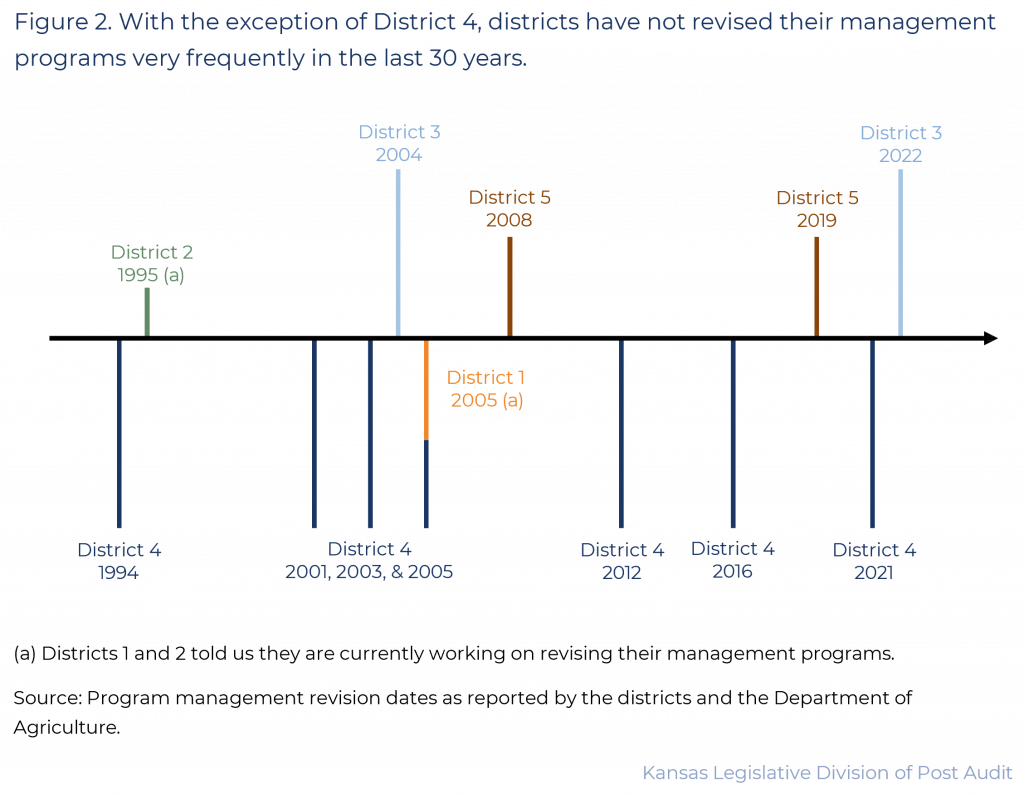
- Additionally, districts do not have adequate formal written policies that direct when or how they revise their management programs. Districts told us they review data and solicit input from the public and other organizations when determining what revisions to make. Additionally, they all told us they make revisions only when they think it is necessary. A lack of a formal written policy means districts may not consider revising as often as they should. Further, it may lead to inconsistency in evaluating the needs of the district.
District Programs and Concerns
Groundwater management districts currently operate programs related to data collection, research, and public education which appear reasonable for the purposes of groundwater management districts.
- We reviewed districts’ management programs and talked with district managers to determine what programs each district operates. We also reviewed district expenditures to determine which programs districts were currently operating. Further, districts did not have consistent definitions of what constitutes a program. We worked with districts to create as much uniformity as possible.
- Districts have discretion in determining which programs to operate so long as they do not conflict with state law. Kansas statute does not require districts to operate any particular program. Additionally, districts make their own decisions about how they operate programs.
- Districts currently operate a wide variety of programs. Figure 3 shows the programs the districts currently operate. As the figure shows, most districts offer programs related to data collection, research, and public education. However, some districts operate more unique programs. For example, one district is preparing to import water into the district.
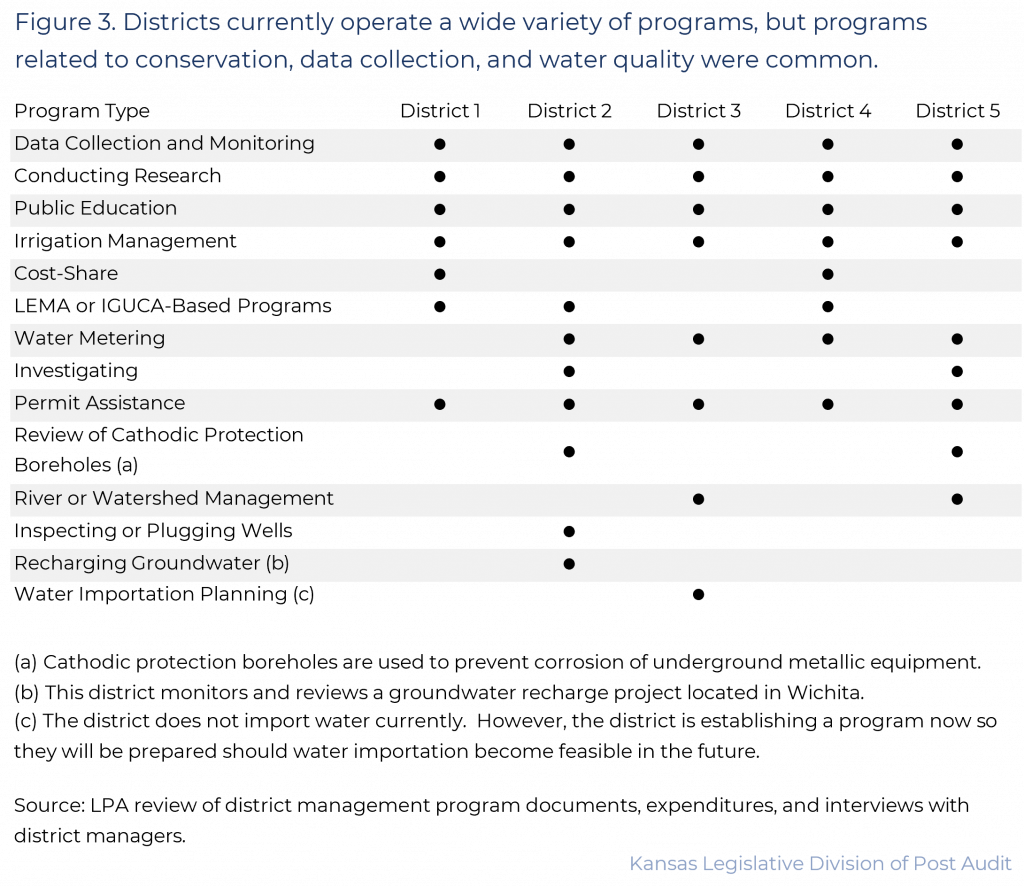
- The programs that districts operate appear reasonable for the purposes of a groundwater management district. The statutory purposes of the districts are broad and mostly relate to managing groundwater in order to support agriculture and the economy. However, as mentioned previously, districts have limited ability to independently manage groundwater through water permitting, aggressive conservation efforts, or influencing statewide water policy. Thus, district programs largely support the broad statutory purposes through monitoring groundwater, research, and public education.
Districts identified many concerns and had programs intended to address them.
- We talked with district managers and reviewed district management programs to understand each district’s primary concerns related to groundwater management. We also talked with district managers to understand the process they use to identify those concerns. We compared the programs that districts operated to their areas of concern to determine whether they had programs that addressed those concerns.
- Each district identified multiple current areas of concern. Figure 4 shows the concerns each district identified. As the figure shows, issues related to the depletion of groundwater were mentioned by all 5 districts. Other concerns included the increased need for water and keeping the public informed.
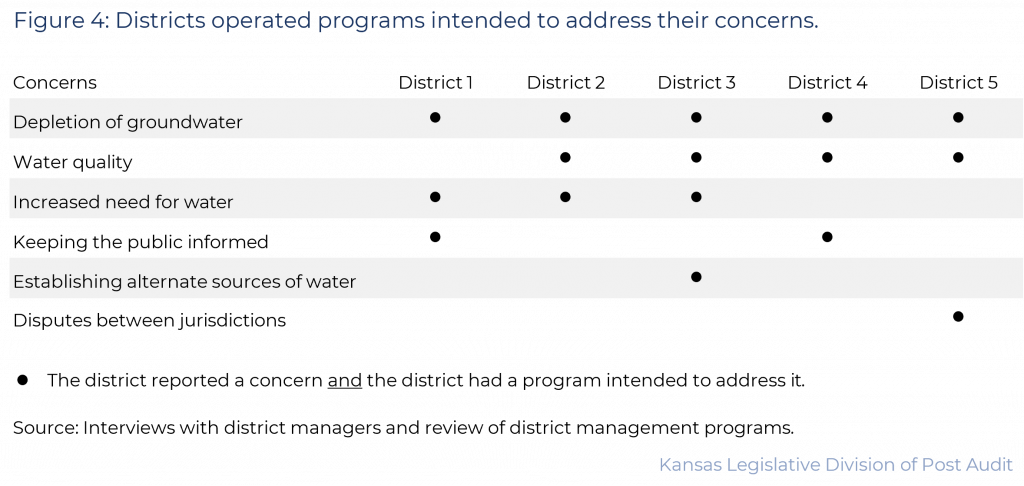
- All 5 districts operated at least 1 program in 2021 that addressed each of their concerns. For example, some districts addressed groundwater depletion concerns by establishing LEMAs. Others established programs to improve irrigation practices.
- In some cases, districts told us they had concerns about issues that could not be addressed easily by programs. In these cases, the concern was something they did not have the authority to remedy. For example, some districts noted they had concerns about their lack of control over groundwater rights. However, who administers groundwater rights is a legislative decision and a district program alone cannot address that concern. Additionally, a couple districts had concerns about the high cost of energy to pump water. However, districts do not have any control over energy costs.
- Districts did not have formal processes for identifying district concerns. However, most told us they review data, work with other organizations, and solicit information from water users. Although their processes are not formal, they do appear to consistently gather information about various concerns.
In 2021, groundwater management districts spent $6.1 million on programs and office administration, but we could not determine the impact the programs had on the districts’ water concerns.
District Expenditures
In 2021, the 5 groundwater management districts spent a total of $6.1 million, mostly on salaries and benefits and professional services.
- We collected expenditure data by various categories and programs from each district for calendar year 2021. We talked with district managers and reviewed documents to understand their expenditures and to ensure reliability.
- In 2021, the districts spent a total of $6.1 million, but spending varied considerably from district to district. For example, District 4 spent about $469,000 while District 5 spent $2.8 million. However, 74% of District 5’s spending was for a one-time land purchase. The district purchased this land to drill wells so they could better monitor groundwater.
- Overall, in 2021 the largest share of district expenditures was for salaries and benefits. Figure 5 shows the distribution of district expenditures for 2021. As the figure shows:
- 41% of district expenditures were for salaries and benefits. Most districts employed 3 full-time staff in 2021. However, District 3 employed 6 full-time employees and 4 part-time employees. Staff included positions such as district managers, office assistants, inspectors, and engineers.
- 21% of district expenditures were for professional services. These included services such as accountants, lawyers, consultants, and lobbyists.
- 14% of district expenditures went toward administrative costs. This included expenses such as rent, utilities, office supplies, and vehicle expenses.
- 24% of expenditures were for other expenses. They largely included expenses associated with grants and non-profit foundations. For example, District 4 operates a non-profit foundation that funds education programs and programs that improve water-use efficiency. The expenses associated with that foundation are included in this category.
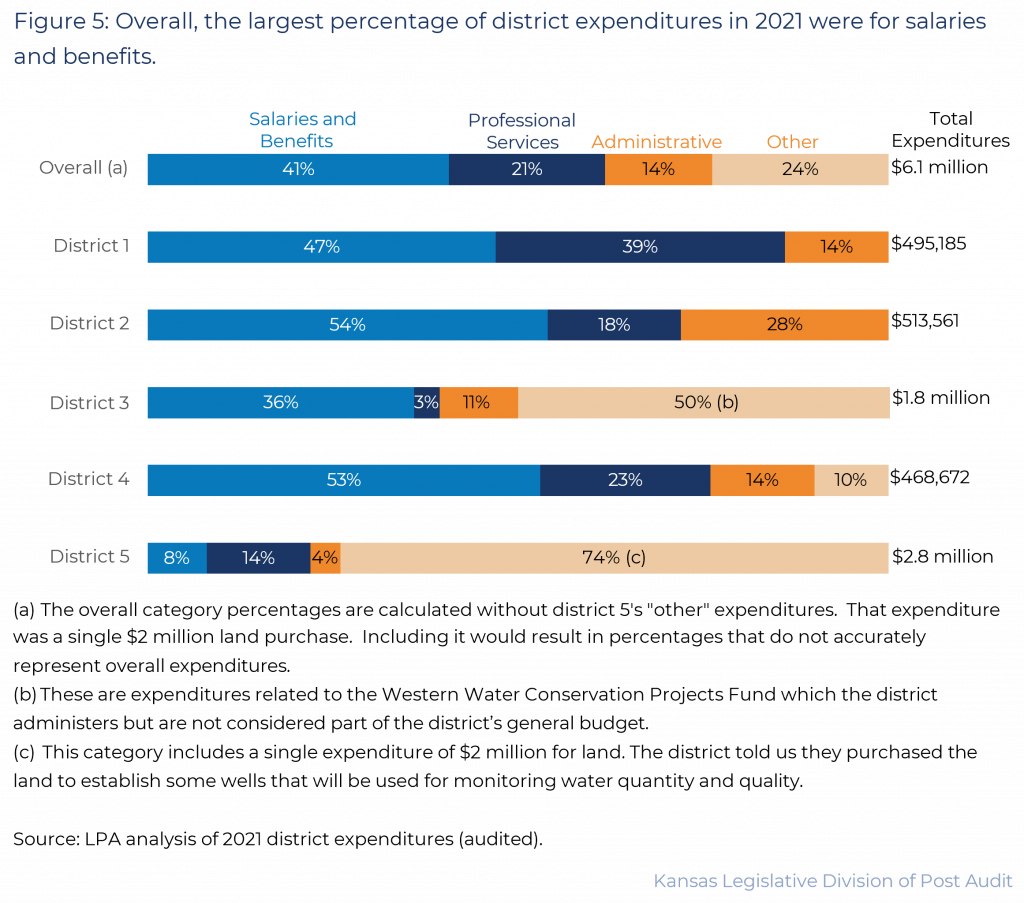
- Of the $10.6 million in total revenue districts reported in 2021, about half (54%) was carried over from prior years. Districts generate revenue primarily through land and water assessments because they do not regularly receive state funding. Many districts generated more revenues through these assessments than they spent on programs, so the surplus rolled to the next year. Districts told us they often have to save money over several years to fund large or long-term projects. This increases the amount of money they carry over from year to year.
Overall, an estimated 75% of district expenditures were for programs related to an area of concern the district identified.
- Districts do not maintain their expenditure data in a way that allowed us to easily answer the audit question. As a result, we had to estimate how much each district spent on their areas of concern by taking two steps:
- First, we worked with districts to estimate how much they spent for each program they operate. Districts do not maintain their expenditure data by program. As a result, we worked with the districts to allocate expenditures to programs. Some expenditures were entirely related to a single program. However, others had to be allocated based on staff time or other metrics.
- Second, we worked with the districts to assign each program to one of the areas of concerns they reported to us. Some program expenditures were allocated entirely to a single area of concern. In other cases, a single program may address multiple areas of concern. In those cases, we estimated which portion of the program expenditures should be allocated to each concern based on input from the district.
- The majority of each districts’ expenditures were for programs that addressed an area of concern. Figure 6 shows that percentage for each district. For example, as the figure shows, an estimated 86% of District 5’s expenditures in 2021 were related to an identified area of concern. The district operated several programs related to research, monitoring water quality, and promoting effective irrigation. These programs addressed concerns related to groundwater depletion and water quality issues.
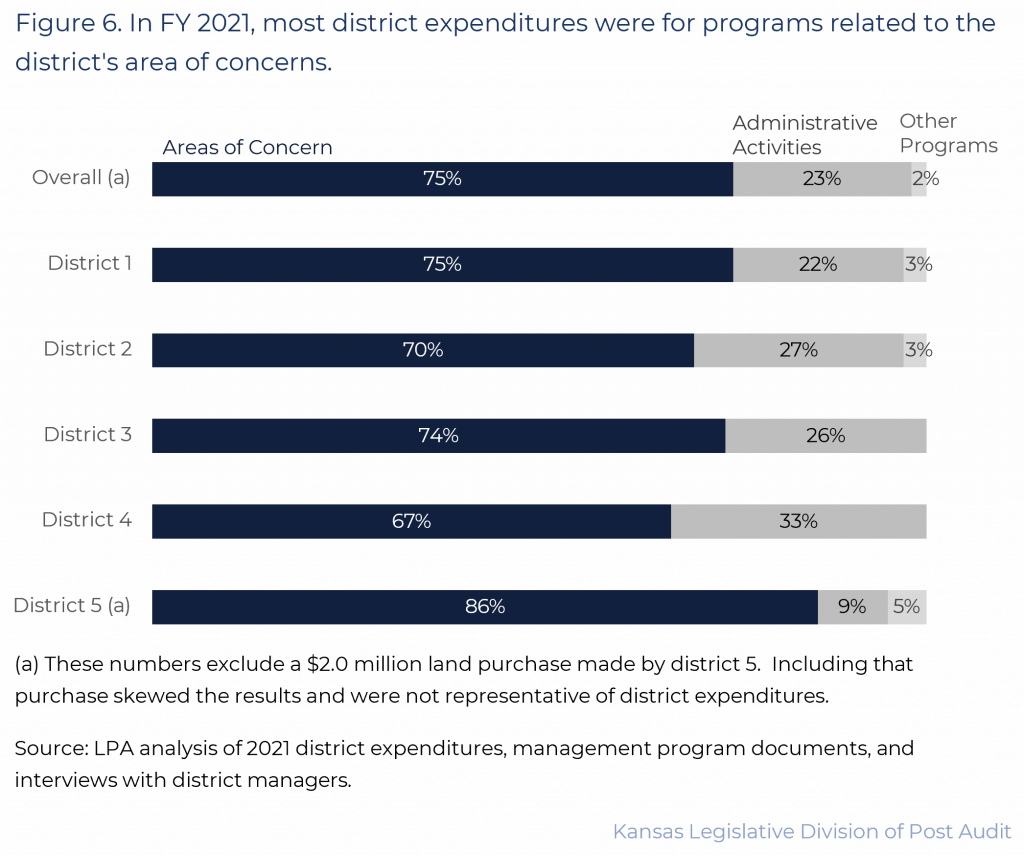
- Additionally, all of the districts spent at least 50% of their expenditures on programs that addressed water quantity concerns. Figure 7 shows the percentage of expenditures each district spent on programs that addressed water quantity and water quality concerns. As the figure shows, the percentage spent on water quantity concerns ranged from 50% to 66%. This included expenditures for programs such as data collection, monitoring, and water conservation efforts (e.g. establishing LEMAs or providing education about conservation practices).
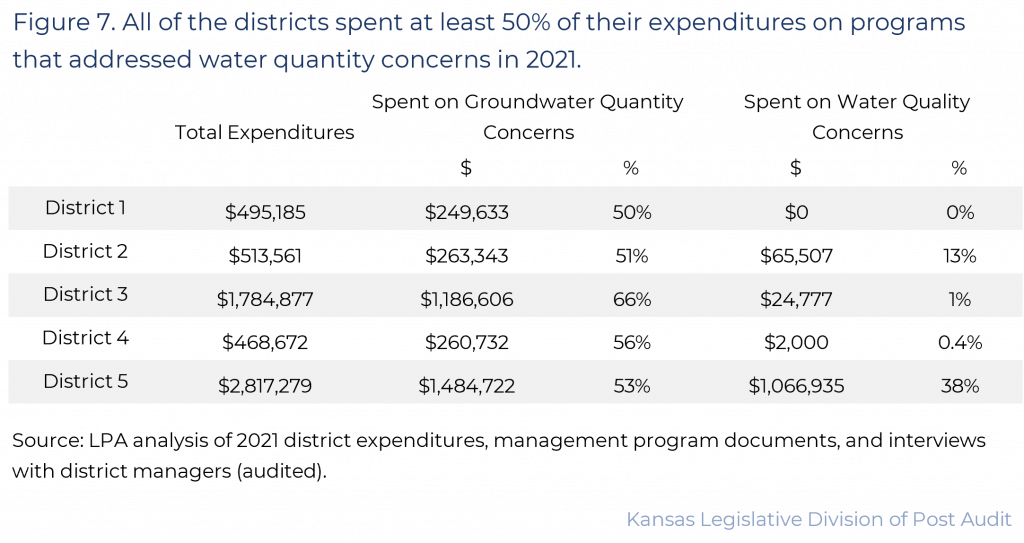
- Expenditures unrelated to districts’ areas of concern were related to the general administration of the district or to other programs.
- Expenditures related to the administration of the district were not allocated to areas of concern. This included expenditures such as utilities, rent, or staff time for general office activities (e.g. payroll or preparing for meetings).
- Additionally, some districts had expenditures for programs that did not address a current area of concern. For example, one district spent nearly $16,000 on expenses for an airplane hangar related to a weather modification program that is currently suspended. District officials told us they are working with a local city government to rent out the space.
- Districts have significant discretion in how they spend their funds. Statute does not require them to fund any specific program or activity. District officials told us they consider factors such as the impact of the program on the aquifer, how many people might benefit, and what provides the best service to the community. Some also told us they consider the impact on land and water assessments in their district when determining how to spend money.
Program Effectiveness
In the last 10 years, 3 of the 5 groundwater management districts experienced overall water level declines, but we could not evaluate water quality.
- We reviewed water level and water quality data to understand current conditions within each district. We used data provided by the Kansas Geological Survey. We consulted with them to determine which measurements were the most reliable and representative. We compared groundwater measurements taken in 2012 to measurements taken in 2022.
- Groundwater measurement data showed that 3 of the 5 districts had overall declines in groundwater levels over the last 10 years. Districts 2 and 5 in central Kansas have had slight increases. However, these measurements represent the average for the district. Figure 8 shows how water levels have changed over the last 10 years in the districts. As the figure shows, in some districts, there are areas where the water level is improving although other areas are declining. Groundwater levels may change for several reasons, including fluctuations in the amount of rain or changes in the amount of pumping.
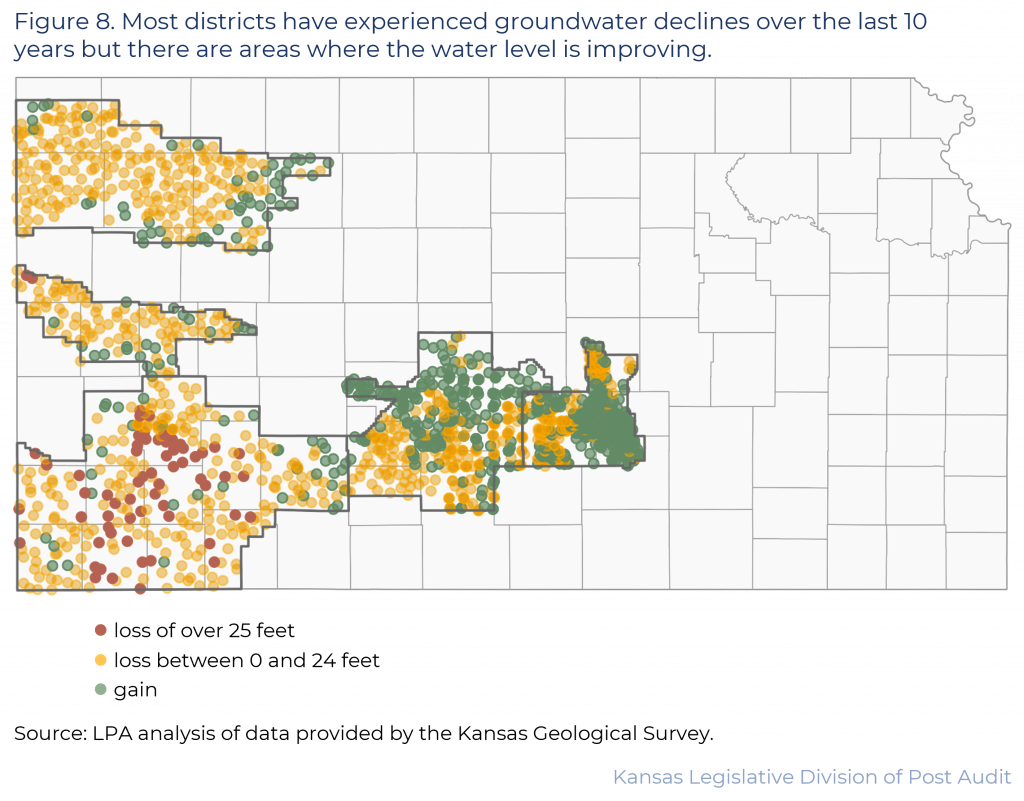
- Although we reviewed water quality data provided by KDHE, we were unable to determine whether quality improved over the last 10 years. All 5 districts have experienced some groundwater quality issues over the last decade. Most issues were related to nitrate contamination. However, we could not determine whether those issues have improved because when a well is contaminated it is sometimes abandoned or filtered to clean the water. In these cases, the contamination data may indicate an improvement although the well is still contaminated. As a result, accurately determining trends was not possible.
We could not determine the impact district programs had on these trends, but some research suggests some positive results.
- As noted above, each district had its own set of concerns. However, all 5 districts reported water quantity concerns. Further, given the importance of this issue, we focused on determining whether district programs adequately addressed that specific concern.
- Determining the effectiveness of district programs intended to address water quantity issues is a complex task.
- Isolating the effects of one program operated by one agency is difficult. Districts operate many programs to address water quantity issues. Further, a number of other agencies also operate programs that directly impact these problems.
- Environmental factors also increase the complexity of understanding the effectiveness of a district program. Rain, temperature, and other climate issues can influence groundwater quantity. An understanding of those issues and how they matter is necessary for evaluating whether district programs are effective.
- Due to time, data, and expertise limitations we were unable to determine whether district programs effectively addressed the concerns they identified.
- However, we reviewed studies by the Department of Agriculture and other researchers on the effectiveness of certain conservation measures. These measures were implemented on the recommendation of the districts and with the approval of the Department of Agriculture.
- The Department of Agriculture and Kansas State University (KSU) have conducted studies of certain conservation methods some districts have implemented. The Department of Agriculture reviewed an IGUCA located in District 2. In 2016, the department found the rate of water level decline in one IGUCA had slowed since it was implemented. Further, it noted that the IGUCA was at least partly responsible for those improvements. A study conducted by KSU in 2017 of an IGUCA in district 5 found that it resulted in statistically significant reductions in water use.
- In 2018, KSU released the results of a 5-year study of one of the LEMAs in District 4. The Kansas Water Office funded the study. It compared the amount of groundwater irrigators used within the LEMA to the amount of groundwater used outside of it. The study found that the LEMA resulted in a 16% reduction in average groundwater use per acre.
- The districts do not consistently monitor the effectiveness of their programs. None of the districts have formal written processes or policies for monitoring the effectiveness of the programs they operate. Districts told us they gather public feedback to understand whether their programs are effective. For certain types of programs, this process may be adequate. For example, gathering informal feedback about whether public education programs are effective may be useful. Other programs, such as data collection, are not measurable for effectiveness. Further, monitoring the effectiveness of programs, such as conservation efforts, often involves long-term study or significant data analysis. In these cases, the districts do not appear to have the expertise and resources necessary to consistently determine whether those types of programs are effective. However, other agencies such as the Kansas Geological Society or the Department of Health and Environment do monitor and study issues related to water quantity and quality in Kansas.
Other Finding
Kansas’ groundwater management districts were similar to those in 4 other states we reviewed.
- We interviewed staff and reviewed documents related to groundwater districts in 4 other states. We chose those states because they had organizations similar to Kansas’s groundwater management districts. Further, like Kansas, three of the states also share the Ogallala aquifer. The states we selected were Colorado, Idaho, Nebraska, and Texas.
- Kansas groundwater management districts operate similar programs to those in the other states we reviewed. Kansas districts operate many programs related to conservation efforts. This includes managing irrigation practices and requiring water meters. They also operate programs related to water quality such as plugging wells and monitoring data. All 4 other states we reviewed also operated similar programs that addressed water quality and quantity issues. For example, Texas districts operate programs to monitor water quality and provide education. Additionally, Idaho monitors groundwater levels and operates programs to recharge aquifers.
- Like Kansas districts, all 4 other states utilize management programs or similar plans. In Texas and Nebraska, a plan is required by state law. In Texas, it must be updated every 5 years. In Idaho and Colorado, officials told us the districts have management programs or similar plans but are not required to do so.
- Districts in other states are structured similarly to Kansas’s groundwater management districts. Similar to Kansas, all 4 other states’ districts were local units of government and were governed by a board. Additionally, Kansas and the 4 other states all had the authority to levy assessments to generate revenue.
- However, we also noted a difference. In Kansas, district management programs are reviewed by the Department of Agriculture. However, in all four other states management or other programs are reviewed by a natural resource or environmental agency. For example, in Texas, district management plans are reviewed and approved by the Texas Water Development Board. Additionally, in Nebraska, the Director of Natural Resources reviews district management programs.
Conclusion
Recommendations
1.The Legislature should consider requiring districts to update their management programs on a set timetable.
2. Groundwater management districts should develop written policies that describe when and how they will revise their management programs.
- The Western Kansas Groundwater Management District No. 1 has reviewed this recommendation and plans to implement the recommendation to develop written policies that describe when and how we will revise the District’s Management Program. The District is currently working to revise the District’s Management Program in 2023.
- The Groundwater Management District No. 2 will develop a formal District Standard and Policy by reviewing its existing written procedure for revising the district management program and modify as needed, including the addition of how often the management program will be revised.
- GMD3 will revise the official management program for southwest Kansas.
- GMD #4 intends to implement the recommendation.
- Big Bend Groundwater Management District No. 5 does not have an issue with developing and utilizing written policies to guide the revision process of the management program. Over the District’s history, the District has developed several policies to guide operations of the District. This management program policy can be implemented with minor impact to the operations of the District going forward and will provide future boards of directors with guidance on the process. Historically, the District has had issues with delay in review of a proposed management program by KDA–DWR. It is reasonable that KDA–DWR also develop and implement a policy for the review and approval of proposed management programs from the groundwater management districts. This will provide reasonable timelines and process guidance for current and future KDA–DWR staff.
Agency Response
On January 20, 2023 we provided the draft audit report to the 5 groundwater management districts and the Department of Agriculture. Although all the districts responded to the recommendations, some chose to not provide any further response. Additionally, because we did not make a recommendation to the Department of Agriculture, their response was optional. The department chose not to submit a response. Responses from those districts who chose to provide a further response are below. District officials generally agreed with our findings and conclusions.
Groundwater Management District #2 Response
Equus Beds Groundwater Management District No. 2
Response to the Kansas Legislative Division of Post Audit Report
“Evaluating Groundwater Management Districts’ Efforts to Conserve Water,
February 2023”
by
Tim Boese, Manager
February 3, 2023
The Equus Beds Groundwater Management District No. 2 appreciates the opportunity to provide a response and comments to the audit. The district provided an extensive amount of requested information and data for the audit over several months and realizes that the auditors likely had a daunting task to compile the information from five diverse groundwater management districts into one report. The district applauds and appreciates the efforts of the auditors. While the district recognizes that perhaps having one report for all five districts was necessary in this case due to time and resource constraints, it may have been helpful to have separate sections with relevant details about each district and their programs and activities, which would help answer the three questions which make up the objective of the audit.
The purpose and goals of the Equus Beds Groundwater Management District No. 2, as stated in the district’s management program, are to properly manage the Equus Beds Aquifer by preventing groundwater mining by balancing groundwater withdrawals with recharge, and by protecting the quality of the aquifer. To achieve these goals, the district board of directors has, since the inception of the district in 1975, been proactive and remains active in establishing regulations, programs, special management areas, and monitoring activities, some of which are highlighted below.
- One of the state’s first safe yield criteria in 1980 for reviewing new water permit applications.
- The McPherson Intensive Groundwater Control Area (IGUCA) in 1980 to address declining groundwater levels in a portion of McPherson County.
- Two water quality special management areas in the 1980s to address oil field saltwater contamination – the Burrton IGUCA and the Hollow-Nikkel Special Water Quality Use Area.
- An enhanced well spacing special management area in Reno County to reduce impairment risks by requiring new non-domestic wells to be spaced farther away from existing wells, and a subsequent reduction in the safe yield calculation recharge rates to ensure the area was not over-appropriated.
- Review of the district’s recharge rates and safe yield calculations, resulting in currently proposed reduced recharge rates and modifications to the safe yield regulation for parts of the district.
- Numerous rules and regulations through the appropriate state agencies to address water quantity, permitting, and water quality protection issues.
- The establishment of an extensive monitoring well network consisting of over 500 monitoring wells that the district owns/maintains, and the district annually collects about 3,000 water-level measurements and 300 water samples for analysis.
Thank you for the opportunity to provide a response to the audit and additional information about the Equus Beds Groundwater Management District No. 2.
Groundwater Management District #3 Response
While it is true that Groundwater Management Districts are only allowed to play a limited advisory role in administering the state’s water resources, it is not true that our role in water management is necessarily small. For example, in the ten years leading up to and including the budget year reviewed by the audit, 2012-2021, GMD3 worked to leverage local resources to gain Federal dollars in the following programs:
- Agricultural Water Enhancement Program (2011-2016): Worked with USDA/NRCS to provide $5 million for payments to irrigators in high priority areas to not pump water for a 5-year period.
- WaterSMART System Optimization Review (2011-2014): Coordinated with Spronk Water Engineers to develop a system optimization review to identify inefficiencies within the Arkansas River and irrigation canal systems, and to identify and prioritize projects that would maximize the effectiveness of Western Water Conservation Project Fund dollars with $111,693.03 funding through the Bureau of Reclamation WaterSMART Program. The Western Water Conservation Projects Fund was used to match Federal funding for this program.
- Upper Arkansas Basin Public Water Supply Alternatives Viability Analysis (2012-2014): Coordinated with the Bureau of Reclamation, the Kansas Water Office, Wichita State University Environmental Finance Center, and the Kansas Department of Health and Environment to evaluate deteriorating municipal water supply conditions along the Arkansas River corridor related to high uranium concentrations contaminating groundwater well fields through streamflow infiltration. Examined treatment and conveyance systems that are already in place and developed a plan for affected municipalities to collaborate to address future problems.
- Plan of Study for Arkansas River Corridor (2013-2014): Worked with the Bureau of Reclamation to develop a plan of study for a future collaborative effort between entities in Colorado and Kansas to work together to solve water quality issues in the Arkansas River Basin.
- Evaluation of Mobile Drip Irrigation Technology for Water Use Reduction (2015-2018): Worked with USDA/NRCS and a local producer to install mobile drip irrigation on the inner three spans of center pivots running water from low-capacity wells, evaluate effectiveness, and provide a demonstration to NRCS and the public. This project demonstrated water savings of more than 400 acre-feet during the three-year evaluation period and was funded with $57,800 from the USDA/NRCS Conservation Innovation Grant Program. Funding was matched by the participating producer and in-kind work by GMD3.
- Advanced Irrigation Water Management (2015-2021): Worked with USDA/NRCS to provide cost share payment to farmers for implementation of soil moisture probe technology services for better management of water and provided funding to enhance the Kansas State Mesonet to provide evapotranspiration and climate data to water users. This project was funded with $2.4 million from the USDA/NRCS Regional Conservation Partnership Program and was available for participation for producers within any of the five Kansas Groundwater Management Districts.
- Replacement of Farmers Ditch Headgate and Canal Lining (2019-2021): Replaced the Farmers Ditch Headgate with a new, more efficient structure and lined a portion of the canal with bentonite to reduce seepage loss. This project was funded with $300,000 from the Reclamation WaterSMART Program and $1,465,590 from the Western Water Conservation Projects Fund.
- Irrigation Climate and Resource Evaluation (2021-Present): Create water use and resource evaluation reports (I-CARE) comparing recent water use to local neighbors, using averages and year-to-year data. Reports include aquifer decline data and information detailing the benefits of water use reduction. See http://gmd3.org/icare for more information. GMD3 is collaborating with the City of Garden City, the KGS and Finney County Economic development Corporation to develop these reports using the city’s comparison reporting as a model. This project is being funded with $92,026 from the Bureau of Reclamation WaterSMART Program. This funding is being matched using the current GMD3 meter inspection program as in-kind cost share. The above water project funding amounts to an average of more than $700,000 per year from Federal sources, effectively doubling the GMD3 resources into programs for water planning, conservation, and remediation. Many members of GMD3 reside in communities all across Kansas, from Johnson City to Johnson County, and they are constantly working to bolster their water conservation efforts in GMD3. We greatly appreciate the delegated right from the legislature for local control in solving local water supply problems affecting members who live all across our great state.
Appendix A – Cited References
This appendix lists the major publications we relied on for this report.
- Impact Analysis of the Walnut Creek Intensive Groundwater Use Control Area (2017). Bill Golden and John Leatherman.
- McPherson IGUCA Review (October 2016). Kansas Department of Agriculture.
- Monitoring the Impacts of Sheridan County 6 Local Enhanced Management Area (November 2018). Bill Golden.
